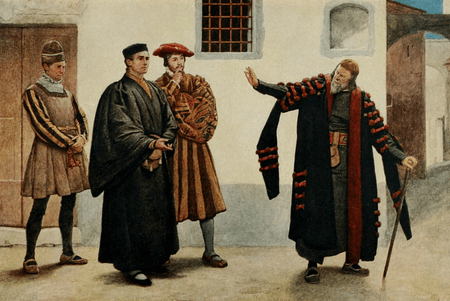Act 3 Scene 1 Merchant of Venice Complete Analysis and Summary
Act 3 Scene 1 Merchant of Venice is one of Shakespeare’s most intense dramatic sequences. It marks the emotional and moral turning point of the play, combining the themes of revenge, justice, prejudice, and human equality. The scene showcases Shylock’s famous speech, “Hath not a Jew eyes?”, which remains one of the most quoted monologues in English literature.
This detailed guide explains the summary, analysis, characters, themes, and literary devices in Act 3 Scene 1 making it the most complete resource for students, researchers, and literature enthusiasts.
Overview of Act 3 Scene 1 in The Merchant of Venice
| Element | Description |
|---|---|
| Play Title | The Merchant of Venice |
| Author | William Shakespeare |
| Act and Scene | Act 3, Scene 1 |
| Location | A street in Venice |
| Main Characters | Shylock, Salanio, Salarino, Tubal |
| Main Themes | Revenge, Equality, Prejudice, Loss, Law vs. Mercy |
| Major Event | Shylock declares his determination to take revenge on Antonio |
Quick Summary (Snippet Ready)
Act 3 Scene 1 of The Merchant of Venice begins with Salanio and Salarino discussing Antonio’s misfortunes at sea. When Shylock arrives, he condemns them for mocking his losses and taunts him about his daughter Jessica’s elopement. His anger erupts into a passionate monologue asserting that Jews and Christians share the same humanity. Soon after, Tubal arrives with mixed news — Jessica is spending Shylock’s money wastefully, and Antonio has lost more ships. Enraged yet triumphant, Shylock vows revenge.
Detailed Summary of Act 3 Scene 1
1. Opening: Antonio’s Ships and Rumors of Ruin
The scene opens with Salanio and Salarino exchanging gossip about Antonio’s ships wrecked on the Goodwins Sands. Their dialogue introduces tension: Venice is buzzing with news of Antonio’s misfortune. This sets the stage for the emotional explosion that follows.
2. Shylock’s Entry and Confrontation
Shylock enters and accuses them of being complicit in his daughter Jessica’s escape with Lorenzo. The Christians ridicule him, saying she “had wings” and flew away. This exchange highlights the cruelty and prejudice Shylock endures daily. His response mixes pain and fury — a father betrayed and a man mocked for his faith.
3. The Famous Speech: “Hath Not a Jew Eyes?”
When Salarino asks if Shylock truly intends to claim a pound of Antonio’s flesh, Shylock delivers one of Shakespeare’s most profound speeches. He asserts that Jews and Christians share identical physical and emotional traits:
“If you prick us, do we not bleed? If you tickle us, do we not laugh?”
This speech shifts Shylock’s image from villain to victim. He redefines revenge as a human, not religious, instinct — claiming moral equality with his oppressors.
4. The Arrival of Tubal
After the Christians leave, Tubal brings updates: Jessica has spent lavishly in Genoa, trading a ring (a keepsake from Shylock’s late wife Leah) for a monkey. Shylock is devastated. Tubal then delivers the news that Antonio’s ships are lost, meaning financial ruin. Shylock’s mood swings from grief to delight — revenge now feels achievable.
5. Closing: Shylock’s Resolution
The scene closes with Shylock’s chilling determination: he instructs Tubal to hire a sheriff to arrest Antonio once the bond expires. The legal trap is set. The audience feels both fear and pity for Shylock’s transformation.
Character Analysis in Act 3 Scene 1
Shylock: The Wronged and the Wrathful
Shylock evolves from a moneylender to a symbol of oppressed humanity. His speech humanizes him, yet his obsession with revenge darkens his morality. He represents both the victim of prejudice and the embodiment of vengeance.
Key traits:
-
Intelligent and articulate
-
Deeply wounded by personal loss
-
Emotionally unstable between grief and fury
-
Obsessed with justice through revenge
Antonio: The Absent Catalyst
Though absent from the scene, Antonio’s misfortunes dominate the dialogue. His losses intensify Shylock’s resolve. Antonio becomes the symbol of Christian hypocrisy a man who despised Shylock yet now relies on his mercy.
Jessica: The Symbol of Betrayal
Jessica’s escape and theft represent cultural and familial betrayal. For Shylock, her flight is more than loss of property; it is loss of legacy. Her actions intensify the audience’s sympathy toward her father’s pain.
Tubal: The Messenger of Duality
Tubal’s role may appear minor, yet he embodies balance. His alternating good and bad news mirrors Shylock’s emotional turmoil. Tubal symbolizes fate’s dual nature giving pain and satisfaction simultaneously.
Thematic Analysis of Act 3 Scene 1
1. Revenge and Justice
Shylock’s demand for revenge stems from years of humiliation. He seeks justice through law, not violence. This blurs moral boundaries — his revenge is legal, but it challenges ethics.
2. Equality and Humanity
“Hath not a Jew eyes?” stands as the earliest literary argument for racial and religious equality. Shakespeare allows Shylock to claim shared humanity before an audience accustomed to bias.
3. Prejudice and Otherness
The mockery by Salanio and Salarino exposes institutional prejudice. Shylock’s Jewish identity isolates him in a Christian-dominated Venice, making his vengeance both social and spiritual.
4. Loss and Grief
Shylock loses his daughter, wealth, and peace of mind. Antonio loses fortune and security. Their mirrored suffering unites them in misery, though divided by faith.
5. Law vs. Mercy
The bond represents cold legality; the courtroom later introduces mercy. This scene foreshadows the clash between rigid law and compassionate justice in Act IV.
Literary Devices Used in Act 3 Scene 1
| Device | Example | Purpose |
|---|---|---|
| Rhetorical Questions | “If you prick us, do we not bleed?” | To evoke empathy and highlight shared humanity |
| Irony | Shylock uses Christian logic to justify revenge | To expose hypocrisy |
| Allusion | Biblical echoes in “Hath not a Jew eyes” | Connects religious morality with human experience |
| Metaphor | “Feed my revenge” | Revenge portrayed as hunger — primal and consuming |
| Repetition | “Let him look to his bond” | Emphasizes Shylock’s legal and emotional fixation |
| Contrast | Jessica vs Shylock | Illustrates generational and cultural divide |
Structure and Dramatic Technique
-
Exposition through Dialogue – The opening gossip contextualizes Antonio’s situation.
-
Conflict through Confrontation – Shylock’s anger shifts scene tone from casual to tragic.
-
Emotional Climax – The “Hath not a Jew eyes?” monologue peaks in pathos.
-
Falling Action – Tubal’s entry transitions tension into cold determination.
-
Foreshadowing – Shylock’s last lines prepare the audience for the courtroom drama.
Psychological Dimension: Shylock’s Inner Conflict
-
Anger: at injustice and mockery.
-
Pain: from Jessica’s betrayal.
-
Greed: interwoven with the need for respect.
-
Revenge: as the only remaining assertion of identity.
His emotions swing sharply, showing how personal trauma and social oppression merge into a destructive obsession.
Symbolism in the Scene
| Symbol | Meaning |
|---|---|
| Bond | The fragility of justice and moral law |
| Gold/Jewels | Material temptation and betrayal |
| Flesh | Literal and symbolic price of revenge |
| Leah’s Ring | Lost purity and sentimental humanity |
| Ships | Fortune’s uncertainty and human helplessness |
Historical and Cultural Context
Shakespeare wrote The Merchant of Venice between 1596 and 1598, when Jews were officially banned from England. Shylock thus reflects Elizabethan stereotypes yet also challenges them. The “Hath not a Jew” speech predates Enlightenment humanism by a century — making this scene revolutionary for its time.
Venetian commerce, maritime trade, and the legal system form the backdrop. The ships symbolize economic risk, while the bond mirrors capitalist contracts where humanity often becomes secondary.
Critical Interpretations
-
Humanist View: Sees Shylock’s speech as a call for universal equality.
-
Moral View: Judges his revenge as unethical despite valid grievance.
-
Psychoanalytic View: Reads Shylock’s rage as displaced paternal grief.
-
Post-colonial View: Interprets his alienation as resistance against dominant Christian authority.
Each perspective enhances the understanding of how Act 3 Scene 1 captures the complexity of moral judgment.
Educational Importance
Teachers often use this scene to illustrate:
-
Character motivation and moral ambiguity
-
Rhetoric and persuasive speech in Elizabethan drama
-
Religious and racial representation in Shakespearean literature
Students studying for examinations should focus on Shylock’s monologue, the legal motifs, and the theme of humanity.
Shylock vs Antonio
| Aspect | Shylock | Antonio |
|---|---|---|
| Religion | Jewish | Christian |
| Occupation | Moneylender | Merchant |
| Motivation | Revenge and justice | Friendship and loyalty |
| Attitude Toward Law | Uses law to assert power | Relies on mercy |
| Emotional Core | Anger and grief | Sorrow and acceptance |
| Fate in Scene | Strengthened | Doomed |
Observations by Literary Experts
-
Shylock’s monologue transforms the audience from judge to witness.
-
Tubal’s dialogue shows how minor characters shape destiny.
-
The use of money and emotion blends realism with morality — rare in Elizabethan drama.
-
Shakespeare’s genius lies in giving the persecuted a voice that transcends time.
Key Lessons from Act 3 Scene 1
-
Understand that injustice breeds vengeance.
-
Realize that religion does not define morality.
-
Accept that law without compassion becomes cruelty.
-
Recognize that words can humanize even the villainized.
-
Learn that revenge destroys both the victim and the avenger.
FAQs About Act 3 Scene 1 Merchant of Venice
Q1. What happens in Act 3 Scene 1 of The Merchant of Venice?
Salanio and Salarino discuss Antonio’s losses. Shylock enters, angry about his daughter’s betrayal. He vows revenge and delivers the “Hath not a Jew eyes” speech. Tubal then reports that Antonio’s ships are lost, making Shylock determined to claim his bond.
Q2. What is the significance of Act 3 Scene 1?
It marks the emotional turning point of the play. Shylock transforms from comic antagonist to tragic avenger. The scene introduces moral complexity and foreshadows the courtroom drama in Act 4.
Q3. Why is Shylock’s speech so famous?
It is a timeless statement on human equality. By asserting that Jews and Christians share the same human traits, Shylock dismantles the foundations of prejudice.
Q4. How does this scene connect to the theme of mercy?
The absence of mercy in this scene prepares for the later courtroom debate between Shylock’s legalism and Portia’s plea for compassion.
Q5. What is the emotional tone of the scene?
It shifts from sarcastic humor to grief, then to rage and triumph. Shakespeare builds tension through alternating pity and fear.
Q6. What does the ring from Leah symbolize?
The ring symbolizes love, loyalty, and memory. Jessica’s act of trading it for a monkey reveals moral decay and deepens her father’s sense of betrayal.
Q7. How does Tubal affect Shylock’s mindset?
Tubal amplifies Shylock’s conflicting emotions — sorrow for his daughter and joy for Antonio’s downfall. His alternating news keeps Shylock’s fury alive.
Q8. What literary devices are most important in this scene?
Rhetorical questions, irony, metaphor, and repetition dominate. They heighten emotional resonance and argument strength.
Q9. How does this scene portray prejudice?
The Christian characters mock Shylock’s grief and faith, exposing systemic intolerance in Venetian society.
Q10. What moral lesson does the scene convey?
Hatred creates endless cycles of suffering. Justice without empathy leads to destruction — a lesson still relevant in modern society.
Learn More: Tooth Sensitive Toothpaste: The Definitive Guide to Relief and Protection
Single Instance Store: Complete Guide for 2025
Conclusion
Act 3 Scene 1 is not merely a transition it is the dramatic fulcrum on which the entire play pivots. Shakespeare constructs a dialogue between justice and revenge, faith and humanity, legality and mercy. Through Shylock’s anguish and Antonio’s misfortune, he reveals how human dignity transcends religion, status, or wealth.






